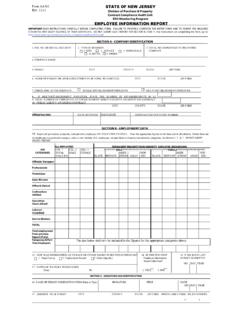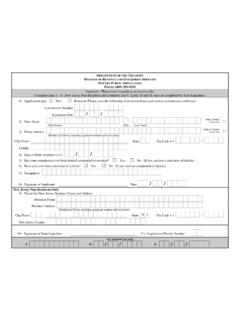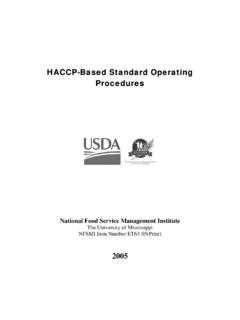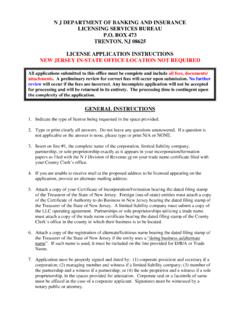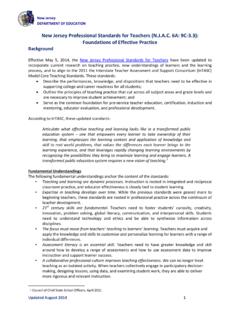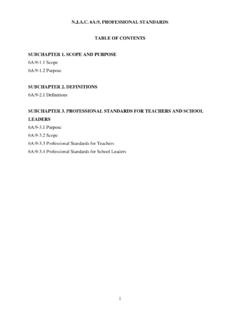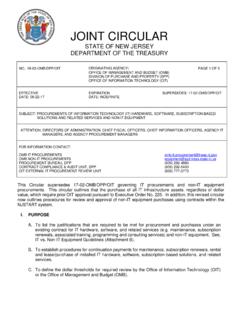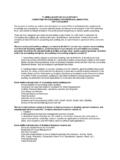Transcription of Internal Affairs Policy Procedures 2017.Final - New …
1 Internal Affairs Policy & Procedures Internal Affairs Policy & Procedures . Issued August 1991. Revised November 1992. Revised November 2000. Revised September 2011. Revised July 2014. Revised November 2017*. Table of Contents Internal Affairs Policy & Procedures .. 1. Table of Contents .. 1. Introduction .. 3. Fundamentals of the Disciplinary Process .. 6. Policy Management System .. 6. Prevention of Misconduct .. 9. Responsibility for Discipline .. 10. Fitness for Duty .. 11. Internal Affairs Unit .. 12. Duties and Responsibilities .. 12. Selection of Personnel for the Internal Affairs Unit.
2 13. Accepting Reports of Officer Misconduct .. 14. Accepting Reports Alleging Officer Misconduct .. 14. Immediate Suspension Pending Investigation and Disposition .. 16. Investigation of Internal Complaints .. 18. Time Limitations .. 18. Investigation and Adjudication of Minor Complaints .. 19. Investigation and Adjudication of Serious Complaints .. 20. Domestic Violence Incidents Involving Agency Personnel .. 23. Internal Affairs Investigation Procedures .. 24. Interviewing the Complainant and Civilian Witnesses .. 24. Reports, Records and Other Documents .. 25. Physical Evidence.
3 25. Photographs .. 25. Physical Tests .. 26. Drug Testing .. 26. Polygraph .. 27. Search and Seizure .. 27. Electronic Surveillance .. 29. Lineups .. 30. Investigation of Firearm Discharges .. 30. Collateral Issues .. 31. 1 11/2017. * These revisions incorporate the modifications concerning mandatory notification to complainants set forth in Attorney General Law Enforcement Directive No. 2017-2. Internal Affairs Policy & Procedures Interviewing Members of the Department .. 32. General Background .. 32. Criminal Investigation, Officer Is Subject .. 35. Criminal Investigation, Officer Is Witness.
4 36. Administrative Investigation, Officer Is Subject .. 36. Administrative Investigation, Officer Is Witness .. 38. Interviewing Procedures .. 38. Internal Affairs Records .. 40. The Internal Affairs Report .. 40. Internal Affairs Records .. 40. Retention Schedule .. 41. Confidentiality .. 42. Reporting .. 43. Personnel Records .. 45. Risk Management Procedures .. 46. 2 11/2017. Internal Affairs Policy & Procedures Introduction Internal Affairs Policy & Procedures was first published in 1991. Updates to the Policy were issued in 1992, 2000 and 2011. The purpose of the Policy is to assist the State's law enforcement agencies with investigating and resolving complaints of police misconduct that originate with private citizens or are generated by the supervisors, officers or employees of a law enforcement agency.
5 The goals of the Policy are to enhance the integrity of the State's law enforcement agencies, improve the delivery of police services and assure the citizens of New Jersey that complaints of police misconduct are properly addressed. This Policy can also be more broadly applied to non-law enforcement employees. See DCJ 11. (currently being revised to apply to all Department of Law and Public Safety employees). Since the introduction of the Policy , the process we call " Internal Affairs " has come under increasing scrutiny by the courts, the community and the media. In fact, it would be fair to say that the proper administration of the Internal Affairs function by the State's law enforcement agencies is a critical issue for the criminal justice system in New Jersey today.
6 The New Jersey Legislature recognized the importance of the Internal Affairs function in 1996 with the enactment of 40A:14-181. The statute provides that: Every law enforcement agency shall adopt and implement guidelines which shall be consistent with the guidelines governing the " Internal Affairs Policy and Procedures " of the Police Management Manual promulgated by the Police Bureau of the Division of Criminal Justice in the Department of Law and Public Safety, and shall be consistent with any tenure or civil service laws, and shall not supersede any existing contractual agreements.
7 In addition, the courts, particularly the federal courts, have focused on the importance of the Internal Affairs function. They have come to perceive this function as an important means of protecting the constitutional rights and civil liberties of the state's citizens. Under the case law, law enforcement agencies must do three things under the Internal Affairs function. First, agencies must implement an Internal Affairs Policy that provides for a meaningful and objective investigation of citizen complaints of police misconduct. Second, agencies must monitor and track the behavior of police officers for incidents of misconduct.
8 Third, when officers are found to have engaged in misconduct, agencies must correct the behavior. The courts have with increasing frequency issued decisions that set minimum standards of performance for the Internal Affairs function. In view of these developments, the Attorney General has issued, through the Division of Criminal Justice, this revised and updated version of Internal Affairs Policy & Procedures . The revisions attempt to incorporate and reflect the numerous changes that have occurred in l a w enforcement and the Internal Affairs function since the Policy was first issued in 1991.
9 The revised Policy is also designed to assist law enforcement agencies in their efforts to comply with emerging legal principles governing the Internal Affairs function. It is important for county and municipal law enforcement agencies to recognize that, as they conduct Internal Affairs investigations, they do so under the general supervision of the Attorney General. The Criminal Justice Act of 1970 designates the Attorney General as the State's chief law enforcement officer. ( 52:17B-98). As such, the Attorney General is responsible for the general supervision of the State's law enforcement agencies to provide for the efficient administration of the criminal justice system.
10 Subordinate law enforcement agencies, including county and municipal police forces, have a duty to cooperate with the 3 11/2017. Internal Affairs Policy & Procedures Attorney General to improve the administration of the criminal justice system, including the efficient delivery of police services. For county and municipal law enforcement agencies, cooperation in Internal Affairs matters begins with strict adherence to the Attorney General's Policy requirements. County and municipal law enforcement agencies must also recognize that they conduct Internal Affairs investigations, particularly those that involve allegations of criminal conduct, under the direct supervision of the county prosecutors.

